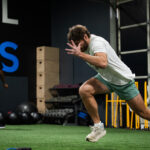Soccer Performance Training for Core Strength
When you think of soccer training, you probably picture sprinting drills or shooting practice. But there’s one key element every serious player needs: a strong core.
Soccer performance training that focuses on core strength improves everything—balance, control, injury prevention, and even shot power. A weak core leads to poor mechanics, slower movement, and more injuries.
Let’s break down why the core matters and how to train it the right way for soccer.
Why Core Strength Is Vital for Soccer Players
The “core” isn’t just your abs. It includes your lower back, obliques, pelvis, and hips. These muscles work together to stabilize your entire body.
Core strength helps players:
-
Change direction quickly
-
Shield the ball from defenders
-
Maintain control under pressure
-
Improve shot and pass power
-
Avoid common injuries like groin pulls or lower back pain
Healthline explains that a strong core enhances movement efficiency and supports nearly every physical action.
Key Core Exercises for Soccer Performance Training
Train your core the right way—not just with crunches. These movements target stability, rotation, and dynamic control.
1. Planks
-
Engage your entire core
-
Hold for 30–60 seconds
-
Try side planks to hit obliques
2. Dead Bugs
-
Strengthens deep core muscles
-
Lie on your back, arms and legs extended
-
Lower opposite arm and leg together, return, and switch
3. Russian Twists
-
Sit on the ground, lean back slightly
-
Rotate side to side with or without a weight
-
Strengthens obliques and rotational power
4. Stability Ball Rollouts
-
Place hands or forearms on a Swiss ball
-
Roll forward while keeping your core tight
-
Enhances control and balance
5. Hanging Leg Raises
-
Great for lower abs and hip flexors
-
Hang from a bar, lift legs up slowly
-
Keep movement controlled and steady
Position-Specific Benefits of Core Training
Midfielders
Control the ball under pressure and stay stable through tackles.
Defenders
Hold your ground during physical challenges and stay upright when clearing the ball.
Forwards
Generate more power in shots and maintain balance while turning or shooting.
Goalkeepers
Improve diving, lateral movement, and posture on saves.
Sample Core-Focused Workout Plan
Incorporate this 3-day core training routine into your weekly soccer performance training plan:
Day 1 – Stability Focus
-
Plank – 3 x 45 seconds
-
Dead Bug – 3 x 10 reps/side
-
Stability Ball Rollouts – 3 x 12
Day 2 – Rotation & Control
-
Russian Twists – 3 x 20 twists
-
Side Planks – 3 x 30 seconds/side
-
Bird Dogs – 3 x 10/side
Day 3 – Dynamic Core Strength
-
Hanging Leg Raises – 3 x 10
-
Medicine Ball Slams – 3 x 12
-
Cable Woodchoppers – 3 x 10/side
Add this after your main training session or on recovery days.
Tips for Core Training Success
✅ Train consistency over intensity
Your core muscles respond best to regular work, not just max-effort sessions.
✅ Focus on control, not just reps
Quality movement beats quantity. Keep your core engaged the whole time.
✅ Incorporate core into your warm-ups
Dynamic core drills are great for movement prep.
✅ Mix static and dynamic movements
Combine holds like planks with powerful movements like slams or chops.
Looking for a soccer-specific strength and core plan? Next Level Athletics builds custom training to fit your game and goals.
Common Core Training Mistakes to Avoid
❌ Only doing crunches
Crunches don’t train the deep muscles that stabilize your spine and hips.
❌ Rushing reps
Speedy reps often mean bad form. Go slow and feel each movement.
❌ Skipping the core completely
Ignoring core training can lead to poor performance and nagging injuries.
❌ Forgetting the lower back and hips
Your core includes your back and glutes. Don’t leave them out.
Conclusion: Build a Core That Supports Your Game
If you want to stay strong, move smarter, and perform better on the pitch, core strength is non-negotiable. Soccer performance training that includes a balanced core routine helps prevent injuries and unlocks next-level control.
Train your core with intention, stay consistent, and integrate these movements into your routine. The results will show in your stability, strength, and overall play.


Recent Comments